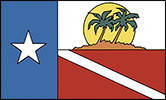Why dive deep?
There are plenty of things to see below sixty feet. This is the depth limit you trained for in your PADI Open Water course. Some reefs, swim-throughs and wrecks are beyond your training depths but lay within recreational dive limits. Such as, Devil’s Throat in Cozumel, the wreck of the Hilma Hooker in Bonaire or the much lauded Blue Hole in Belize. All of these amazing dives are deep and require the skills you‘d get from your Deep Diver course. In fact, every dive at the Flower Gardens National Marine Sanctuary is a deep dive.
How your Deep Diver course works
Your Deep Diver course consists of four dives over sixty feet with a PADI Instructor and some book work. During these dives you will take into consideration the things you learned dryside. These include the effects of added pressure, the loss of colors at depth and gas management. Deep diving requires a bit more planning than shallow dives. We’ll go over planning your deep dives, buddy contact procedures and safety considerations. Also, you’ll learn about the specialized equipment used in deep diving and how to deal with narcosis.

Keep in mind that one of the required dives of your Advanced Open Water course is a deep dive. This dive is considered dive one of your Deep Diver specialty. So, if you’re already AOW certified then you’re already on your way to getting your Deep Diver specialty!
Where can you dive deep locally?
The closest place for us to get some deep dives in is at Wheeler Branch in Glen Rose, TX. We put a buoy out a few years back that marks the area where we can get to the depths required for training. We hold the Deep Diver certification course on the same weekends as our Advanced Open Water courses. However, if you'd rather get your certification in blue water we can make this happen on many of our dive trips, like at the Flower Gardens!
